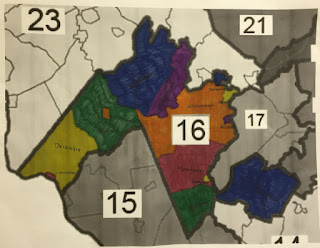A Visit From The Claw
'Twas the month before Christmas, when all through the town,
The streets were chocked full of great mounds of brown--
Yardwaste and tree limbs, dumped without care,
In hopes that the street crew soon would be there.
The kids, how they wished they could jump in a pile
Of leaves dry and crisp, where they'd linger awhile.
But all dreams were dashed! Their dad called a halt
To such thoughts of venturing near the asphalt.
The streets had become so exceedingly narrow,
That bicyclists mixed with the cars at their peril.
The street drains were clogged, the rains made a river.
I watched this insane spectacle with a shiver.
When just down the way there arose such a clatter.
I sprang to the door to see what was the matter.
From round the next corner at once there appeared
A caravan that was demonstrably weird.
With dump truck and pickup and street crew I saw
A giant contraption with grappling claw
That groaned as it scooped up the leaves in great gobs.
One thing that was clear was they wouldn't lose their jobs.
For no sooner did they the street cleaner make,
Than neighbors dumped even more leaves in their wake.
The mounds they grew higher than ever before.
I guessed that our town had gone nuts at the core.
How could such a state of affairs come to pass?
What sense underlies this self-made morass?
Is decomposition a thing to be purged
From yards prim and proper that so blandly merge?
The leaves, they have value, it's clear, don't you see?
To earthworms and robins and flowers and trees.
Let's make room between the back fenceline and shrubs,
And there place the leaves as good food for the grubs.
Hidden from view they will quietly mellow.
As Jefferson did at beloved Monticello.
To ground they return; no need for more work.
As they flatten and fade, no varmints will lurk.
Let humus and nutrients there feed your soil.
The mulch will kill weeds, and save you some toil.
The leaf-softened ground will soak up the rain
And lessen the floods that now seem to gain.
Or, grind up the leaves as you last mow the grass.
Okay, so it might take just one extra pass.
But saved be our streets from a public display
Of all that in nature is meant to decay.
I know that I'm fighting a dominant force,
That flouts local law as a matter of course.
No bureaucrat dares to deliver a fine,
Risking taxpayer wrath of a virulent kind.
But speak up I must, and speak up I will
As long as the streets continue to fill.
This dumping is wrong. It's an ongoing blight.
To all who love sense: Let's fight the good fight!
Background (from original post on Dec. 14, 2011): Yesterday, a man overheard me talking to a friend at the Arts Council about all the leaves clogging the streets. He came over and said that West Windsor has the same problem, and that their town council had just thrown its hands up in exasperation, for lack of a solution to the annual deluge of leaves. The thought of towns all over New Jersey struggling with the same intractable problem, mixed perhaps with the flush of vitamins from eating swiss chard from the backyard garden, had the unexpected effect of later moving me to verse, which I read yesterday night at the Princeton borough council meeting. When faced with adversity, write a poem. By coincidence, The Claw came by our house as I was writing it. My apologies to Clement Clarke Moore for rerouting his 1822 "A Visit From St. Nicholas" down a very messy street.















































